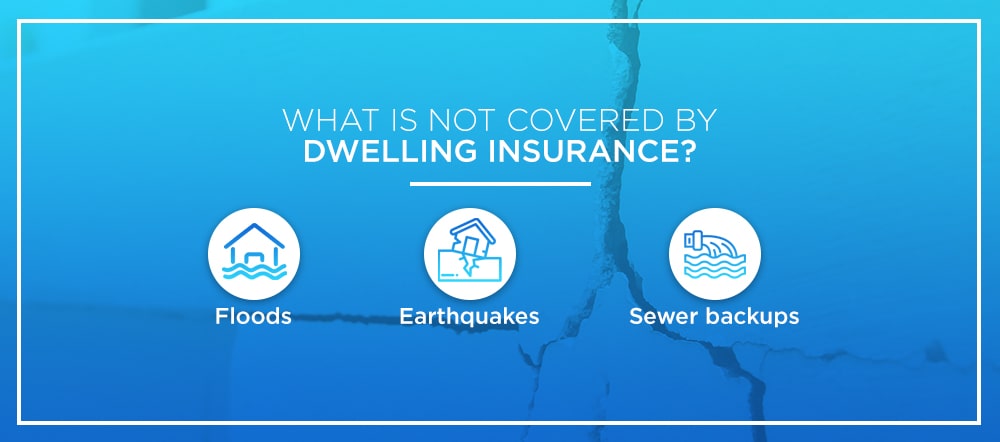Buying a home is in an investment in multiple ways. In the run-up to your home purchase, you likely invested time and effort into saving up the down payment. You also most likely focused on improving your credit score so that you can qualify for a mortgage and get the best interest rate possible. Once you buy the home, you hope it will provide you and your loved ones with shelter, as well as deliver a return if you decide to sell at a later date.
Purchasing a homeowners insurance policy is one way you can protect your investment. If you’ve taken out a mortgage to help pay for the home, your lender will likely require you to have a homeowners policy. Multiple types of homeowners policies exist, and each policy offers different levels of protection. An HO3 policy is one of the more popular options. HO3 policies include dwelling insurance and can also offer liability protection and personal property protection.
For many homeowners, dwelling insurance might be the most important part of a homeowners insurance policy, as it provides coverage for the structure of the home itself. Learn more about how dwelling insurance fits under the homeowners insurance umbrella, what type of protection it provides and what it doesn’t protect against.

Dwelling insurance offers financial protection in certain circumstances if something happens to the structure of your home. It is a part of a homeowners insurance policy or hazard insurance policy.
Homeowners insurance offers financial protection should your home be damaged or if a loss should occur due to theft, accidents or a natural or human-made disaster. When you buy a homeowners insurance policy, it often includes four components:
Liability protection provides coverage if you or someone in your household —including pets — damages another person’s possessions or causes bodily harm to another person. For example, if your dog bites the postal carrier or if your teenager breaks a neighbor’s vase, your homeowners liability protection will cover some or all of the costs and protect you in the event of a lawsuit.
Personal belongings protection covers damage to or loss of items you own, such as a refrigerator or clothing. Additional living expenses coverage will pay the cost of a hotel or other accommodation if you cannot stay in your home or need to spend time away from your home due to damage caused by a covered event.
Dwelling insurance provides coverage for the foundation, walls and roof of the home. It also insures structures attached to the house, such as a garage. Many dwelling insurance policies also offer a limited amount of protection for detached structures, such as a separate shed in the backyard or a detached garage. In the interior of your home, dwelling insurance covers any built-in appliances, such as your HVAC system or water heater. It also includes protection for built-in fixtures such as showers, toilets and kitchen sinks.
How much protection dwelling insurance offers depends in large part on the value of your home, the cost to replace it if it is severely damaged or destroyed, and the amount of insurance you purchase. In many cases, your lender will require you to buy enough coverage to adequately protect the home.
The maximum coverage available from a dwelling insurance policy is the dwelling limit. When you are shopping for homeowners insurance, make sure you choose a policy that offers a high enough dwelling limit to cover the cost of rebuilding your home if needed. You might choose to purchase increased dwelling coverage, such as extension coverage, which would reimburse you for more than the rebuild cost of your home. Dwelling extension coverage insures a home for up to 150% of its rebuild cost.
The size of the dwelling limit will affect the insurance premium. The higher the limit, the higher the premium.
Dwelling insurance, also known as Coverage A, protects your home against several different hazards. Generally speaking, the following areas are considered part of your dwelling and would be protected under Coverage A:
Structures that are on your property but aren’t connected to your home might be covered by dwelling insurance, but the amount of coverage is generally a small fraction of the dwelling limit. For example, coverage for a detached shed or garage might be just 10% of your dwelling limit. If you want to protect detached structures more fully, your best option might be to purchase other structures coverage, also known as Coverage B, as part of your homeowners insurance policy. Personal property coverage can provide protection for large items such as an above-ground swimming pool or trampoline.
Along with understanding what your dwelling insurance policy covers, it’s also important to know what types of perils or hazards the coverage protects against. While the exact list of perils will vary based on your policy or your state, here are some of the hazards that most policies will protect against:
There might be exceptions to the list of items that are considered perils or hazards under your insurance policy. For example, if a tree falls on your home and the tree was damaged by an infestation of pests, your insurance might not pay to repair the damage. It’s always a good idea to read your policy closely so you know exactly what it protects you against.

Although dwelling insurance offers protection against a long list of hazards, it doesn’t protect against every possible concern. There are some notable hazards that aren’t covered by dwelling insurance, such as:
Another thing to note is that dwelling insurance will not pay to repair damages that occur as a result of neglect or lack of maintenance. As a homeowner, it’s up to you to take good care of your home and the things inside of it. If there’s a leak somewhere in the house and water damage builds up over time, eventually causing part of the structure to collapse, there is a chance your insurance won’t cover it. The same is true of damage that occurs as a result of neglected appliances, such as a furnace or air conditioner that was never tuned or a water heater that was never flushed.
When you’re shopping around for homeowners insurance and dwelling coverage, it’s important to choose a policy that provides the right amount of coverage. Too little coverage and you are likely to find that you need to pay a lot out of pocket to repair or rebuild your home after damage. If you buy a policy that offers more coverage than you actually need, you can end up overpaying for insurance.
The insurance company you work with will most likely recommend a coverage limit to you, usually based on the market value or purchase price of your home. Since the value of a home isn’t always the same as the cost to rebuild it, it can be worthwhile to take a few minutes to calculate what it might cost you if you did need to rebuild your home. You can calculate the cost by multiplying the square footage of your house by the average construction costs per square foot in your area. Your insurance agent can help you determine the average cost of construction.
It’s also worth considering the materials used to build your home and its style when determining the amount of coverage to buy. An older home might be more expensive to rebuild than a newer one of the same size if the materials needs are more costly.

You likely hope nothing will happen that damages the structure of your home, but the best thing you can do is protect yourself financially. Purchasing a homeowners insurance policy does exactly that. The dwelling insurance coverage that is included in the most commonly purchased homeowners policies gives you peace of mind that your home and your bank account are protected.
In many cases, you are required to buy dwelling insurance when you purchase a home, especially if you are getting a mortgage to pay for the house. You’re not the only one who wants reassurance that your investment is protected. Your lender also wants to make sure that the property that’s acting as collateral on your home loan is insured.

When you’re in the midst of the home buying process, you need to make decisions quickly. You might not have time to read every single insurance policy that comes your way carefully, or you might feel confused about the different coverage options available. David Pope Insurance works with homebuyers in St. Clair, Union and Washington, Missouri. We’ll help you find and choose the homeowners insurance policy that works with your budget and provides you with the coverage you need to adequately protect what’s likely to be your largest investment. Contact us today to learn more and to sign up for our newsletter.